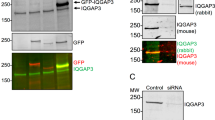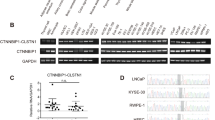Abstract
The guanine nucleotide releasing protein C3G was initially identified as a Crk SH3-binding protein and recently shown to exhibit exchange activity on Rap1 proteins. Overexpression in NIH3T3 cells of a full-length C3G cDNA isolated from human placenta markedly reduced the focus forming activity of cotransfected, malignantly activated, ras oncogenes (5 – 7-fold). C3G also had a reverting effect on sis-mediated transformation, decreasing the number of c-sis-induced foci by a factor of 5 – 10-fold. The observed inhibitory effect of C3G on focus-forming activity of Ras and Sis was always higher than that observed with Rap1A, a known target of C3G. The inhibition of focus formation observed in the presence of C3G was not due to toxic effects on cell viability, since transfected C3G cells exhibited the same survival and growth rates as untransfected NIH3T3 cells or cells transfected with plasmid vector alone. Surprisingly, as opposed to Rap1A, which has no effect on Raf-1 oncogene-mediated transformation, C3G also reduced dramatically (6 – 8-fold) the number of v-raf-induced foci in transfected NIH3T3 cells. The inhibitory effect on Raf-induced transformation suggests that C3G has other functional targets in addition to Rap1. A C3G mutant (C3G δCat) lacking the catalytic domain (CDC25-H) but retaining the rest of the N-terminal sequences, including the Crk-binding domain, exhibited similar ability than full length C3G to inhibit focus formation. In contrast, a C3G mutant (C3G Cat), containing the catalytic domain only but lacking the rest of the N-terminal sequences, did not have any inhibitory effect on transformation mediated by the oncogenes tested. The C3G-derived gene products overexpressed in our transfected cell lines localized to the cytoplasm and did not change the basal MAPK or JNK activity of those cell lines nor their ability to activate the kinases in response to agonists. Our results suggest that the N-terminal region of C3G, and not its catalytic domain, may be responsible for the inhibitory effects observed.
This is a preview of subscription content, access via your institution
Access options
Subscribe to this journal
Receive 50 print issues and online access
$259.00 per year
only $5.18 per issue
Buy this article
- Purchase on Springer Link
- Instant access to full article PDF
Prices may be subject to local taxes which are calculated during checkout
Similar content being viewed by others
Author information
Authors and Affiliations
Rights and permissions
About this article
Cite this article
Guerrero, C., Fernandez-Medarde, A., Rojas, J. et al. Transformation suppressor activity of C3G is independent of its CDC25-homology domain. Oncogene 16, 613–624 (1998). https://doi.org/10.1038/sj.onc.1201569
Received:
Revised:
Accepted:
Published:
Issue Date:
DOI: https://doi.org/10.1038/sj.onc.1201569
Keywords
This article is cited by
-
C3G downregulation induces the acquisition of a mesenchymal phenotype that enhances aggressiveness of glioblastoma cells
Cell Death & Disease (2021)
-
C3G contributes to platelet activation and aggregation by regulating major signaling pathways
Signal Transduction and Targeted Therapy (2020)
-
Expression of a novel brain specific isoform of C3G is regulated during development
Scientific Reports (2020)
-
C3G, through its GEF activity, induces megakaryocytic differentiation and proplatelet formation
Cell Communication and Signaling (2018)
-
C3G forms complexes with Bcr-Abl and p38α MAPK at the focal adhesions in chronic myeloid leukemia cells: implication in the regulation of leukemic cell adhesion
Cell Communication and Signaling (2013)



